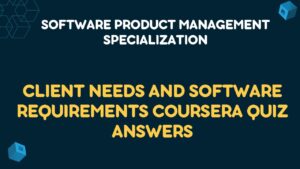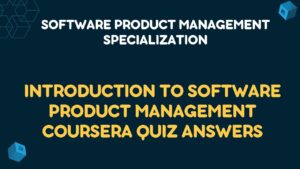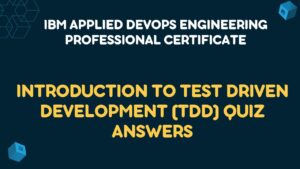Get All Weeks Lean Software Development Coursera Quiz Answers
Table of Contents
Lean Software Development Week 01 Quiz Answers
Quiz 1: Lean Fundamentals
Q1. Which of the following are 5 Lean principles? (Not the 7 principles of Lean software development)
Map the Value Stream
Establish Pull
Seek Perfection
Q2. In terms of “Lean”, what is the best description of Waste?
ViewQ3. Lean techniques define “Value” from the perspective of who?
ViewQuiz 2: Lean Principles
Q1. In Lean software development, how can amplifying learning occur? (Select all that apply)
View2.The developers use short iterations.
Q2. How can waste arise in software development? (Select all that apply)
ViewDevelopers work on rarely used product features.
Q3. In Lean software development, what does the principle of “defer commitment” mean?
ViewQ4. In Lean software development, what does the principle of “deliver fast” mean? (select 2 that apply)
View2.Iterations are short, so feedback is frequent, and product evolution is rapid.
Q5. Which of the following align with the lean principle of “build quality in”? (select 2 that apply)
View2.Instead of focusing on refactoring every sprint, certain sprints are dedicated to focus on quality.
Q6. In Lean software development, what does “optimize the whole” mean? (Select all the apply)
ViewRather than trying to optimize one part, look at the whole system for optimization opportunities.
Q7. Which of the following tools can help you find waste in a process?
View2.5 Whys
Q8. What are some of the tools to amplify learning? (Select all that apply)
View2.Iteration
Q9. How do you deliver fast (i.e reduce cycle time) without compromising the quality?
ViewQ10. “The Last Responsible Moment” is a tool for which Lean Software Principle?
ViewQ11. Lean helps increase productivity by:
ViewQ12. Which practices waste time during software development? (Choose two)
ViewDelays in receiving work products.
Lean Software Development Week 02 Quiz Answers
Quiz 1: Kanban
Q1. Which of these are core properties of Kanban? (Select all that apply)
ViewLimit work in progress
Visualize the Work
Q2. Which of following is valid on a Kanban Board? Select two.
View2.The WIP limit for Step X is 5. Step X is divided into “Doing” and “Done”. The number of items in the “Doing” column is 3, and the number of items in the “Done” column is 1. One of the items in the previous step is done and the developers want to move that item to Step X.
Q3. A software development team just started using Kanban. They had the following columns on their Kanban board, in order from left to right: Backlog, Analysis, Development, Testing, Deployment. Each column has a WIP limit of 3.
There are currently 3 items in testing (3 items being tested). Similarly, there are 3 items in the development column (2 items that are in development and 1 item is done with its development).
One of the developers does not have anything to work on, so the manager wants to add one more item to the development column so the developer looking for work can work on it.
Which of the following are valid next actions in this situation? Select all that apply.
ViewThe manager should ask the deployment team if a done item in the testing column can be deployed so there is space to move an item from development to testing.
The manager should ask the developer waiting for work to help the testers so that they can finish one of the items in their column and move it to the deployment column.
Quiz 2: Kanban, Value Stream Mapping and Kaizen
Q1. The 5 “Whys” to be considered during a Root Cause Analysis are…?
ViewQ2. What is the purpose of the Lean tool ‘Kaizen’?
ViewQ3. Which of the following can be used to do 5 Whys analysis?
ViewQ4. In Kanban, a developer pulls the next item to work on from the:
ViewQ5. You are a developer on a team using a Kanban board to manage flow. You work on Step X within the process and it just so happens that you are looking for more work.
The Kanban board is set up as follows:
Step X has a WIP limit of 3.
Step X is divided into “Doing” and “Done.”
The number of items in the “Doing” column is 2.
The number of items in the “Done” column is 1.
Without violating the rules of the Kanban board, what should you do? Select all that apply.
ViewTalk to the team about adjusting the WIP limit because increasing the WIP limit will create a better flow of work.
Q6. Which of the following statements are true about Value Stream Mapping? Select all that apply.
View2.Value-added activities are activities that add value from the customer’s perspective.
Q7. What is the formula to calculate the Process Cycle Efficiency?
ViewLean Software Development Week 03 Quiz Answers
Quiz 1: Lean Startup
Q1. What is the main goal of the Build-Measure-Learn Cycle?
ViewQ2. What do we mean by Validated Learning?
ViewQ3. Which of the following are principles of Lean startup? Select all that apply.
ViewEntrepreneurs are everywhere
Validated Learning
Q4. Which of the following is true about Lean Startup? Select two.
View2.It is based on going through the Build-Measure-Learn cycle as fast as you can.
Q5. Why are traditional management principles ill-suited to the world of startups?
View2.Because startups face chaos and uncertainty.
Q6. When a startup ‘pivots’, what is it doing?
ViewQ7. According to Ries, which of the following adjectives describes good startup metrics? Select all that apply.
ViewActionable
Auditable
Q8. Which of the following are levels of Pirate Metrics? Select all that apply.
ViewActivation
Retention
Revenue
Acquisition
Q9. Which of the following are true about Pivot or Persevere? Select two.
ViewZoom-out pivot: What was previously considered a single feature in a product becomes the whole product.
Q10. How do Vanity metrics prevent/inhibit pivoting?
ViewQ11. What are three ways that a past customer can drive sustainable growth?
ViewWord-of-mouth referral
Q12. What are the characteristics of “Early Adopters”?
ViewEarly adopters will give you their time and honest feedback.
Q13. What are leap-of-faith assumptions?
ViewQ14. Which of these attributes are favored by Lean startup? Select two.
ViewCustomer feedback
Q15. Who is an “Intrapreneur” ?
ViewLean Software Development Week 04 Quiz Answers
Quiz 1: Design Thinking
Q1. Which of the following are true about Design Thinking? Select 2.
ViewIt is a process for creative problem-solving.
Q2. In design thinking, what are two of the main reasons to empathize with users?
ViewTo discover the real problem to be solved.
Q3. Design thinking results in innovation by integrating which three things?
ViewHuman Desirability
Technical Feasibility
Q4. What are the two dimensions for categorizing assumptions?
ViewImpact on our solution if it is wrong
Q5. What are the two dimensions for categorizing tests?
ViewQuality of data collected from the test
Lean Software Development Course Review:
In our experience, we suggest you enroll in Lean Software Development courses and gain some new skills from Professionals completely free and we assure you will be worth it.
Lean Software Development course is available on Coursera for free, if you are stuck anywhere between a quiz or a graded assessment quiz, just visit Networking Funda to get Lean Software Development Coursera Quiz Answers.
Get All Course Quiz Answers of Software Development Lifecycle Specialization
Software Development Processes and Methodologies Quiz Answers
Agile Software Development Coursera Quiz Answers
Lean Software Development Coursera Quiz Answers
Engineering Practices for Building Quality Software Quiz Answers




